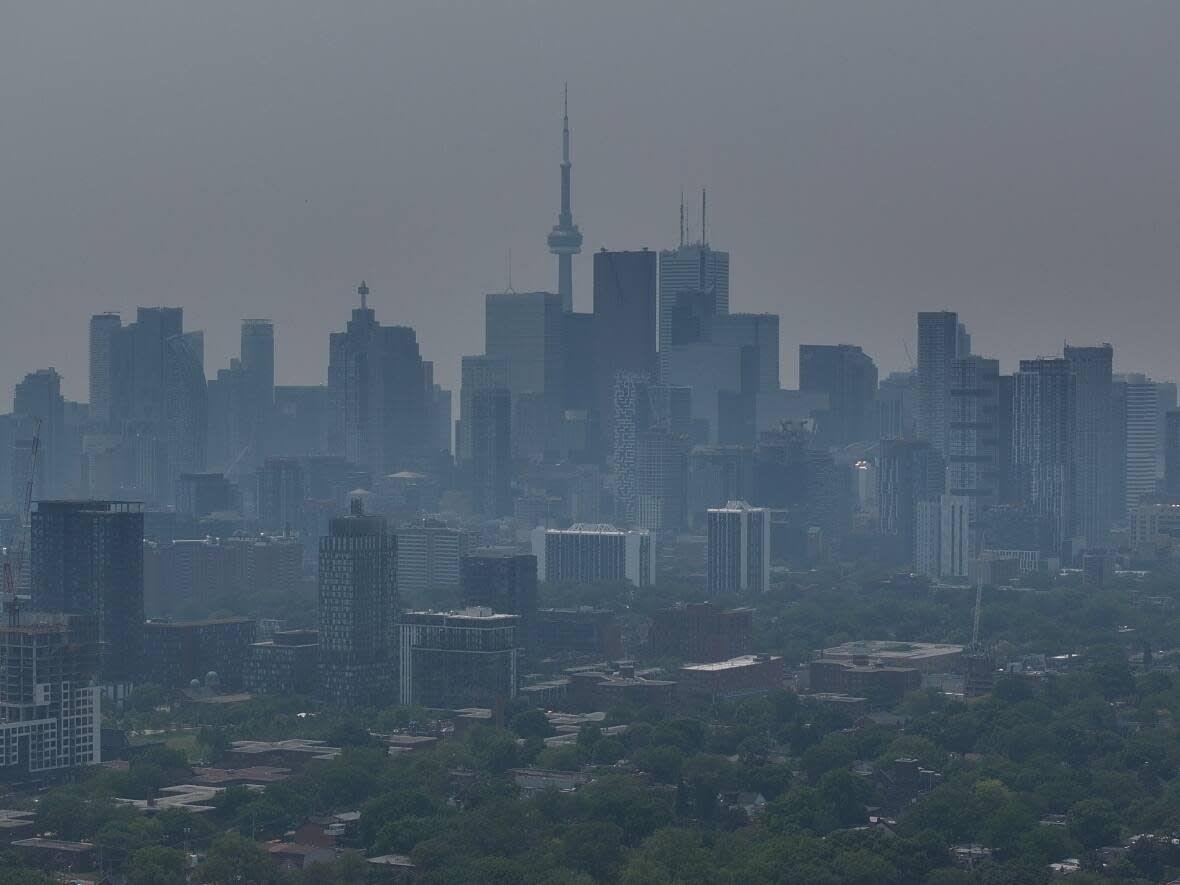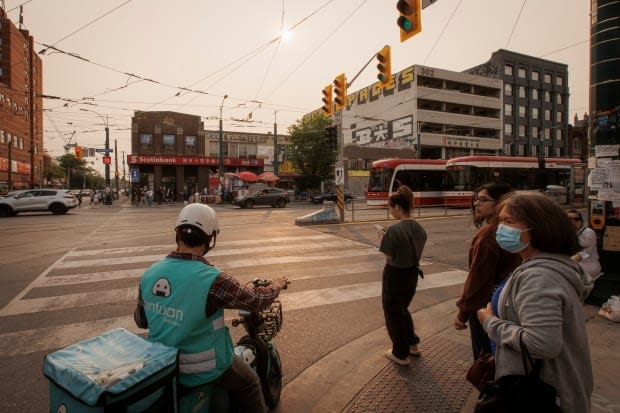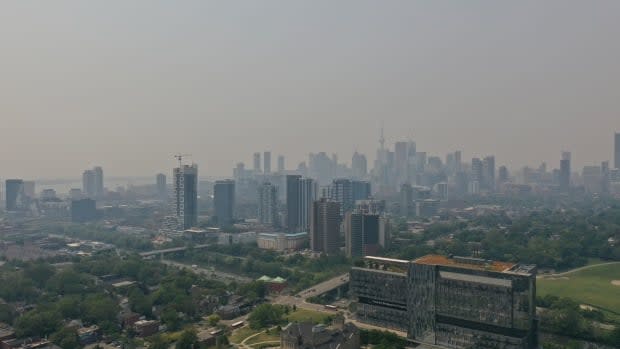Hazy skies from wildfire smoke are blanketing Toronto. Here's what you should know

Smoky skies have blanketed Toronto for several days as air quality conditions continue to deteriorate and prompt advisories for residents to limit their time outdoors.
The smoke plumes drifting from large swaths of Quebec and northeastern Ontario have sent air quality plummeting to unhealthy levels with high pollution reported in the Greater Toronto Area (GTA) since Monday.
That's caused concern from both experts and residents as experts say climate change is only intensifying forest fires.
But how do the fires specifically affect Canada's largest city and what should residents do to mitigate the health risks? When will this be over and how frequently is this forecast to happen?
Here's what you should know.
How are Torontonians affected?
On any given day, Toronto usually sits at around three out of 10 on the Air Quality Health Index (AQHI), which measures air quality based on how it will impact health.
As of Wednesday afternoon, Environment Canada said the air quality in Toronto reached a seven. The risk will drop overnight, however, the federal agency says smoke density is expected to increase Thursday with air quality expected to reach nine by the afternoon.
Experts say high levels of exposure to the fine particulate matter emitted from wildfires — which can lead to eye, throat and nose irritation — can also increase the risk of lung and heart disease.
Environment Canada says those with lung disease, such as asthma, people with heart disease, older people, children, pregnant people and those who work outside are at higher risk of experiencing negative health impacts.
Doctors have previously suggested fine particulate matter (PM 2.5) — a pollutant emitted from anything burning — can exacerbate asthma, lung and heart disease.
Respirologist and associate professor at the University of Toronto's department of medicine Dr. Samir Gupta says that's reason to worry.
"We really should be concerned," Gupta said.
WATCH | Haze blankets Toronto:
Gupta said the air quality is the "worst" that southern Ontario has ever seen.
"These are tiny, tiny particles, and the challenge is that they're small enough that you can breathe them right into your lungs and they go deep into your lungs. The tiniest particles, called nano-particles actually get into the bloodstream from the lungs and can affect many other organs."
"Our respiratory tract has an important barrier function in keeping bacteria and viruses out," Gupta told CBC News Wednesday.
"There's many studies that suggest that even healthy people, when they breathe in enough of these tiny particles, there's an impairment of those barrier functions so there's a higher risk of infections."
What happens to air quality in a dense city?
While Toronto may be dubbed the "Big Smoke" and has many different pollutants that contribute to urban smog, such as from fossil fuels burned in car exhaust and factories, smoke levels from forest fires are worsening air quality in the region.
In a densely populated city, experts say residents must take caution as the risk is spread out no matter where you are.
"Soot is being released with the burning of these forest fires and on those particles a lot of chemicals bind to them," said Matthew Adams, an assistant professor in the department of geography at the University of Toronto Mississauga (UTM).
Whether you're higher up in a building or lower down, in whichever part of the city, the risk remains much the same, Adams said.

How common is this in Toronto?
Climate and health experts agree that it is not common to see the smoky skies in Toronto. But some say to expect more of this as climate change intensifies and prolongs the hot and dry conditions for wildfires to thrive.
"We're experiencing values that are not what we typically see in the GTA very often," said Adams.
"Thankfully it's a rare event for us here in the GTA, but I really do think we're going to be seeing more of this… This is what all the models of climate change predicted across Canada."
Trudy Kidd, a warning preparedness meteorologist at Environment Canada, said while this may seem "unusual" for a big city like Toronto, it is not "uncommon" for northern Ontario communities to deal with smoke every year during fire season.
"It's more unusual for us in southern Ontario to experience the effects from forest fires," Kidd said.
How can residents prepare for this in the future?
The head of the University of Waterloo's Intact Centre on Climate Adaptation, Blair Feltmate, says these conditions were "predictable," and should act as a warning.
"We knew that climate change, that forest fires are becoming and will continue to become more problematic going forward," Feltmate said. "People really need to understand that this is what climate change looks like in action."

Feltmate said while people should anticipate this happening more frequently, the only way to prepare for similar conditions to come is to help slow down climate change.
"Climate change is irreversible … We can slow it down but we can't stop it, so we need to prepare more effectively," he said.
"These extreme conditions — wildfires, flooding — will become more challenging going forward, period."
Feltmate said the smoke levels could also affect flights in coming weeks, especially with more extreme summer heat coming.
How to reduce exposure to smoke levels
Environment Canada says when the index indicates a high level of risk, residents should consider rescheduling or reducing outdoor activities and at-risk populations should reschedule outdoor activities.
For those who have to spend time outside, it says wearing a well-fitted respirator type mask like an N95 can help reduce exposure to fine particles in smoke.
It also recommends the following:
If you or someone in your care experiences shortness of breath, wheezing, severe cough, dizziness or chest pains, stop outdoor activities and contact your health care provider.
If you feel unwell and experience symptoms, stay inside.
Keep your indoor air clean.
Keep your doors and windows closed if the temperature in your home is comfortable.
Take a break from the smoke by temporarily relocating or finding a place in your community with clean, cool air such as a library, shopping mall or community centre.
If you must spend time outdoors, consider wearing a well-fitted respirator type mask that does not allow air to pass through small openings between the mask and your face.
Be sure to check on people in your care and those who may be more susceptible to smoke.
Evacuate if told to do so.
Review your wildfire smoke plan and make sure you have enough medical supplies if the smoke continues to be an issue.
Environment Canada says poor air quality will persist into the weekend with a low pressure system expected to bring cleaner air by Sunday.


